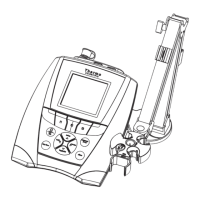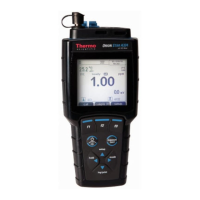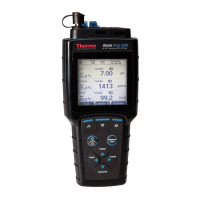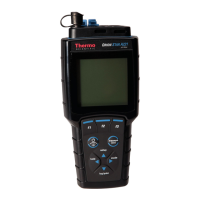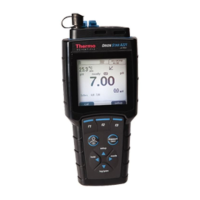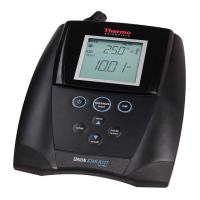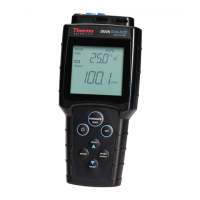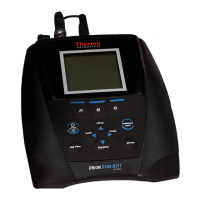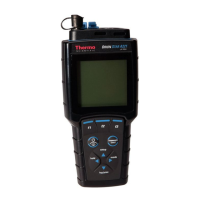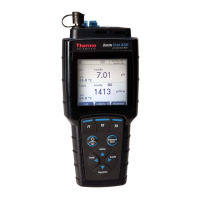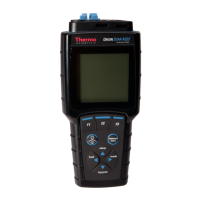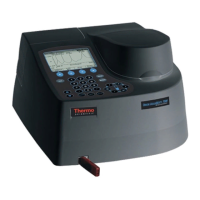
Do you have a question about the Thermo Scientific Orion AquaMate 8000 UV-Vis and is the answer not in the manual?
| Brand | Thermo Scientific |
|---|---|
| Model | Orion AquaMate 8000 UV-Vis |
| Category | Measuring Instruments |
| Language | English |
Details on safety and special notices including notes, important information, cautions, and warnings.
Describes the major external components of the spectrophotometer like the sample compartment and keypad.
Details the location and types of connectors on the back of the instrument.
Explains the function of each key on the instrument's keypad, including function keys and navigation keys.
Describes the types of cell holders included and available for the Orion AquaMate spectrophotometers.
Details the 6-position cell holder and its use with cuvettes.
Describes the single cell holder and its use, including notes on its initialization.
Provides guidance on selecting cuvettes based on material and compatible wavelength ranges.
Explains the Z-dimensions and beam size specifications of the instrument.
Instructions on how to input parameter values using the keypad, including numeric and alphanumeric entry.
Guide on navigating menus and selecting options using the keypad for instrument setup.
Explains how to toggle settings between ON and OFF states.
Details the process of entering text strings for parameters like test names.
Covers setting non-test hardware parameters like date, time, and screen contrast.
Step-by-step guide to setting the instrument's date, time format, and time.
Information on the standby mode settings to prolong lamp life and its factory default.
Explains how to set a time limit for the validity of a collected baseline.
Instructions on adjusting the screen contrast for better readability.
Describes sampling and system accessories, focusing on cell holders and their configurations.
Presents a table of available cell holders and their accessories for instrument customization.
Details the process of initializing the cell changer or cell holder upon starting a measurement.
Provides reasons and instructions for changing cell holders for different applications.
Step-by-step guide for installing the 6-position and single cell holders.
Instructions on how to properly remove the installed cell holders from the instrument.
Guidance on installing other accessory cell holders, referencing baseplates and securing mechanisms.
Information on connecting and using external printers with the spectrophotometer.
Describes the Auto 6 measurement option for measuring multiple samples sequentially.
Explains the Auto 3 measurement option for measuring a blank and two samples.
Details the Manual 3 setting specific to the Water Analysis test.
Describes the manual measurement process using a single cell holder.
Instructions for manual measurements using the cell changer with up to five samples.
Explains how to perform cell correction to account for variances between cuvettes.
Steps to set up the correction mode, including Scan and Discrete nms options.
Guide on specifying wavelengths and the number of matched cuvettes for discrete nms mode.
Information about the password feature to lock or unlock test setups.
Instructions for assigning a unique alphanumeric name to a test.
Explains the options for saving test methods to internal memory or an external device.
Guide on how to load saved test files from internal memory via the Utility screen.
Procedure to lock or unlock stored tests using a password.
Instructions on how to delete a stored test from the instrument.
Steps to configure a single test to load automatically upon instrument power-up.
Procedure to remove a test from the SmartStart menu.
Guide for setting up multiple tests to appear in the SmartStart menu.
Details the basic concentration units available for results labeling.
Instructions on creating and adding custom concentration units to the list.
Step-by-step guide on using the instrument's built-in calculator for basic arithmetic.
Procedure for copying and loading water analysis test methods from a USB stick.
Steps to run a water analysis test method that has been loaded from a USB drive.
Guide to running water analysis tests stored in the instrument's library.
Instructions for running water analysis tests selected from the SmartStart menu.
Details on executing a loaded water analysis test, including blank and sample measurements.
Guide on creating new methods or modifying existing factors in water analysis tests.
Explains how to use one-point adjustment for accurate measurements with preprogrammed methods.
Describes reverse color methods where concentration increases with decreasing absorbance.
Steps to run a preprogrammed reverse color method, including blank and reagent blank measurements.
Guide on programming a new reverse color test, including setting factors.
Instructions for setting the desired wavelength for absorbance or %T measurements.
Procedure for measuring a blank sample to establish a baseline for measurements.
Steps for measuring sample absorbance or %T values.
Procedure to recall a previously saved test in advanced mode.
Guide for configuring test parameters for advanced Abs/ %T measurements.
Steps for taking measurements in advanced Abs/ %T mode, with or without a cell changer.
Procedure for collecting a baseline scan for wavelength scanning.
Instructions for scanning a sample to obtain its absorption or transmission spectrum.
How to view and manipulate scan results in graphical or tabular format.
Procedure for rescaling graphical scan data using auto or manual scales.
Details on performing calculations like labeling peaks and smoothing data.
Instructions for labeling peaks and valleys on a scan graph.
Guide on using the smoothing function to reduce noise in scan data.
Procedure to determine peak height using a 3-point net equation.
Instructions for calculating the area under a peak in the scan graph.
How to view and rescale scan data presented in a tabular format.
Configuring parameters for multiwavelength measurements.
Procedure for adding specific wavelengths and their corresponding factors for measurement.
Instructions on removing wavelengths and factors from a multiwavelength test.
Steps to perform multiwavelength measurements automatically.
Steps to measure samples for absorbance ratio analysis.
Instructions for measuring samples for absorbance difference analysis.
Details on using the Absorbance Ratio screen for various test functions.
Procedure to take measurements using the 3-Point Net application.
Guide to setting parameters and measuring standards to create a calibration curve.
Steps for measuring samples using a previously created standard curve.
Instructions on modifying a standard curve by changing data points or curve fit.
Details on setting parameters for measuring standards for a calibration curve.
Procedure for measuring standards to build a standard curve.
Explains how to use the Standards screen to view results, graphs, and edit curves.
Steps for measuring samples in kinetics analysis.
How to view and recalculate graphical kinetics data.
Procedure for rescaling and recalculating tabular kinetics data.
Steps to access the instrument's performance verification tests.
Provides a checklist to diagnose common problems with performance verification tests.
Tests the instrument's wavelength accuracy using internal standards.
Measures wavelength accuracy against known standards.
Tests the instrument's ability to return to identical wavelengths repeatably.
Measures the instrument's ability to resolve adjacent spectral features.
Tests absorbance or %T against standards to check accuracy.
Measures the amount of noise in the instrument's readings.
Tests for stray light at selected wavelengths and compares with expected values.
Guidelines for basic routine maintenance to ensure instrument longevity and performance.
Detailed instructions for cleaning cuvettes and other cells based on sample type.
Procedure for cleaning the sample compartment windows without damage.
Instructions for replacing the instrument's fuse, including fuse ratings.
Step-by-step guide for safely replacing the tungsten lamp.
Explanation of various parameters used in instrument operations and tests.
Formulas and methods for calculating standard curves, including partial sums.
Explains linear regression calculation for absorbance vs. concentration.
Details the calculation of linear regression when the line passes through the origin.
Describes the segmented model for standard curve fitting.
Criteria for validating standard curves, including ascending or descending slopes.
Formulas for calculating statistics like standard deviation and correlation coefficient.
Formula for calculating absorbance ratio between two wavelengths.
Formula for calculating the difference in absorbance between two wavelengths.
Formula for calculating baseline corrected absorbance using a 3-point net.
Formula for baseline corrected absorbance as per ASTM E169-04 standard.

